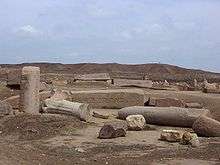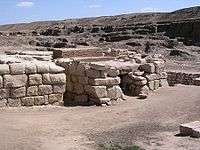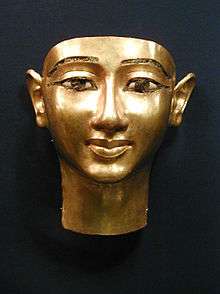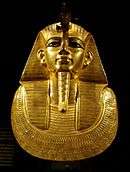Tanis
|
Djanet صان الحجر | |
 The ruins of Tanis today | |
 Shown within Egypt | |
| Location | San El-Hagar, Al Sharqia Governorate, Egypt |
|---|---|
| Region | Lower Egypt |
| Coordinates | 30°58′37″N 31°52′48″E / 30.97694°N 31.88000°ECoordinates: 30°58′37″N 31°52′48″E / 30.97694°N 31.88000°E |
| Type | Settlement |

Tanis (/ˈtænɪs/; Ancient Greek: Τάνις; Ancient Egyptian: ḏˁn.t /ˈɟuʕnat/ or /ˈcʼuʕnat/[1]; Arabic: صان الحجر Ṣān al-Ḥagar; Coptic: ϫⲁⲛⲓ/ϫⲁⲁⲛⲉ[2]) is a city in the north-eastern Nile Delta of Egypt. It is located on the Tanitic branch of the Nile which has long since silted up.
History
| ||||||||||
| Djanet (ḏˁn.t) in hieroglyphs |
|---|
Tanis is unattested before the 19th Dynasty of Egypt, when it was the capital of the 14th nome of Lower Egypt.[3][lower-alpha 1] Most monuments found at Tanis that are datable earlier than the 21st Dynasty, were in fact brought there from nearby cities, mainly from Pi-Ramesses, and reused by the kings of the time. The earliest known Tanite buildings are in fact datable to the 21st Dynasty.[5]
During the late New Kingdom, the royal residence of Pi-Ramesses was abandoned because of its branch of the Nile being silted up and its harbour consequently becoming unusable. After Pi-Ramesses' abandonment, Tanis became the seat of power of the pharaohs of the 21st Dynasty, and later of the 22nd Dynasty (along with Bubastis).[3][5]
The rulers of these two dynasties saw themselves as the legitimate successors on the throne of Upper and Lower Egypt. They used traditional titles and displayed their royalty in building work, although that pales when compared to activity at the height of the New Kingdom.[6] A remarkable achievement of these kings was the building and subsequent expansions of the Great temple of Amun-Ra at Tanis (at the time, Amun-Ra replaced Seth as the main deity of the eastern Delta), while minor temples were dedicated to Mut and Khonsu whom, along with Amun-Ra, formed the Theban Triad.[5] Many of these rulers were also buried at Tanis in a new royal necropolis, which replaced the one in the Theban Valley of the Kings.[5]
In later times Tanis lost its status of royal residence, yet it remained populated until its abandonment in Roman times.[3]
Ruins

Tanis was the site of numerous archaeological digs beginning in the 19th century, involving Flinders Petrie and Auguste Mariette.
In 1866, Karl Richard Lepsius discovered at Tanis the Decree of Canopus—an inscription closely related to the Rosetta Stone, which was likewise written in Egyptian (hieroglyphic and demotic) and Greek. This discovery contributed significantly to the decipherment of hieroglyphics.
There are ruins of a number of temples, including the chief temple dedicated to Amun, and a very important royal necropolis of the Third Intermediate Period (which contains the only known intact royal Pharaonic burials — the tomb of Tutankhamun having been entered in antiquity). Many of the stones used to build the various temples at Tanis came from the old Ramesside town of Qantir (ancient Pi-Ramesses/Per-Ramesses), which caused many former generations of Egyptologists to believe that Tanis was, in fact, Per-Ramesses. However, the burials of three pharaohs of the 21st and 22nd dynasties — Psusennes I, Amenemope and Shoshenq II — survived the depredations of tomb robbers throughout antiquity. They were discovered intact in 1939 and 1940 by Pierre Montet and proved to contain a large catalogue of gold, jewelry, lapis lazuli and other precious stones including the funerary masks of these kings.
The chief deities of Tanis were Amun; his consort, Mut; and their child Khonsu, forming the Tanite triad. This triad was, however, identical to that of Thebes, leading many scholars to speak of Tanis as the "northern Thebes".
In 2009, the Egyptian Culture Ministry reported archaeologists had discovered the site of a sacred lake in a temple to the goddess Mut at the San al-Hagar archaeological site in ancient Tanis. The lake, built out of limestone blocks, had been 15 meters long and 12 meters wide. It was discovered 12 meters below ground in good condition. This was the second sacred lake found at Tanis. The first lake at the site had been identified in 1928.[7]
In 2011, analysis of high-resolution satellite imagery, led by archaeologist Sarah Parcak of the University of Alabama at Birmingham, found numerous related mud-brick walls, streets, and large residences, amounting to an entire city plan, in an area that appears blank under normal images. A French archeological team selected a site from the imagery and confirmed mud-brick structures approximately 30 cm below the surface.[8] However, the assertion that the technology showed 17 pyramids was denounced as "completely wrong" by the Minister of State for Antiquities at the time, Zahi Hawass.[9]
Tanis and the Bible
The Biblical story of Moses being found in the marshes of the Nile River (Exodus 2:3-5) is commonly hypothesized to be located at Tanis. However, no supporting archaeological evidence has been unearthed, and the demise of the city may well have been caused by the relocation of Nile tributaries rather than a non-historical occupation by the Israelites.[10]
In popular culture
In the 1981 film Raiders of the Lost Ark, Tanis is said to be the resting place of the Ark of the Covenant, which was hidden in a secret chamber called the Well of Souls. Tanis is fictitiously described as having been buried by a sand storm until 1936, when it was discovered by a German expedition outside Cairo. In reality, Tanis was the site of numerous archaeological digs beginning in the 19th century.
The novel The World's Desire by H. Rider Haggard is set primarily in Tanis.
See also
Notes
- ↑ Biblical archaeologist Benjamin Mazar believed that the Year 400 Stela, found in Tanis and datable to the 13th century BC, can be an evidence that the site had some settlement in the 18th or 17th century BC.[4]
References
- ↑ Loprieno, Antonio (1995). Ancient Egyptian: A linguistic introduction. pp. 39, 245.
- ↑ Vycichl, W. (1983). Dictionnaire Étymologique de la Langue Copte, p. 328.
- 1 2 3 Snape, Steven (2014). The Complete Cities of Ancent Egypt. Thames & Hudson. p. 335. ISBN 978-0-500-77240-9.
- ↑ Benjamin Mazar, Encyclopedia Miqrait, "Eretz Yisrael", p. 682
- 1 2 3 4 Robins, Gay (1997). The Art of Ancient Egypt. London: British Museum Press. pp. 195–197. ISBN 0714109886.
- ↑ De Mieroop, Marc Van (2007). A History of Ancient Egypt. Malden, MA: Blackwell Publishing. p. 400. ISBN 9781405160711.
- ↑ Johnston, Cynthia. Pharaonic-era sacred lake unearthed in Egypt. Reuters, October 15, 2009.
- ↑ Pringle, Heather Satellite Imagery Uncovers Up to 17 Lost Egyptian Pyramids 27 May 2011
- ↑ Theodoulou, Michael (May 29, 2011). "Idea of 17 hidden pyramids is 'wrong'". The National. Retrieved October 18, 2016.
- ↑ Lindsay Falvey (2013). "Musing on Agri-History". Asian Agri-History 17(2), p. 184.
Bibliography
- Association française d’Action artistique. 1987. Tanis: L’Or des pharaons. (Paris): Ministère des Affaires Étrangères and Association française d’Action artistique.
- Brissaud, Phillipe. 1996. "Tanis: The Golden Cemetery". In Royal Cities of the Biblical World, edited by Joan Goodnick Westenholz. Jerusalem: Bible Lands Museum. 110–149.
- Kitchen, Kenneth Anderson. [1996]. The Third Intermediate Period in Egypt (1100–650 BC). 3rd ed. Warminster: Aris & Phillips Limited.
- Loth, Marc, 2014. "Tanis – 'Thebes of the North’“. In "Egyptian Antiquities from the Eastern Nile Delta", Museums in the Nile Delta, Vol. 2, ser. ed. by Mohamed I. Bakr, Helmut Brandl, and Faye Kalloniatis. Cairo/Berlin: Opaion. ISBN 9783000453182
- Montet, Jean Pierre Marie. 1947. La nécropole royale de Tanis. Volume 1: Les constructions et le tombeau d’Osorkon II à Tanis. Fouilles de Tanis, ser. ed. Jean Pierre Marie Montet. Paris: .
- ———. 1951. La nécropole royale de Tanis. Volume 2: Les constructions et le tombeau de Psousennès à Tanis. Fouilles de Tanis, ser. ed. Jean Pierre Marie Montet. Paris: .
- ———. 1960. La nécropole royale de Tanis. Volume 3: Les constructions et le tombeau de Chechanq III à Tanis. Fouilles de Tanis, ser. ed. Jean Pierre Marie Montet. Paris.
- Stierlin, Henri, and Christiane Ziegler. 1987. Tanis: Trésors des Pharaons. (Fribourg): Seuil.
- Yoyotte, Jean. 1999. "The Treasures of Tanis". In The Treasures of the Egyptian Museum, edited by Francesco Tiradritti. Cairo: The American University in Cairo Press. 302–333.
 Wendjebauendjed's funerary mask
Wendjebauendjed's funerary mask Wendjebauendjed's cups from Tanis
Wendjebauendjed's cups from Tanis Pharaoh Osorkon II's tomb at Tanis
Pharaoh Osorkon II's tomb at Tanis The gold funerary mask of Psusennes I
The gold funerary mask of Psusennes I
External links
| Wikimedia Commons has media related to Tanis, Egypt. |
- French Archaeological Mission of Tanis (Mission française des fouilles de Tanis)
- Société Française des Fouilles de Tanis
- Archaeology Magazine article on Treasures of Tanis
- Tanis: San el-Hagar
- Tanis in Encyclopaedia of the Orient
- Travel information for Tanis
| Preceded by Pi-Ramesses |
Capital of Egypt 1078 – 945 BC |
Succeeded by Bubastis |
| Preceded by Bubastis |
Capital of Egypt 818 – 720 BC |
Succeeded by Sais |